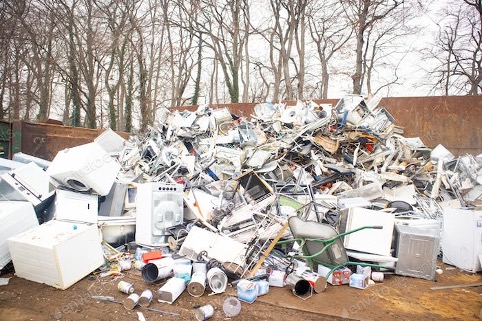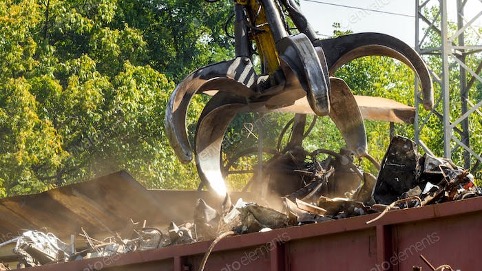We have a great blog post all about the environmental benefits of metal recycling, here. So, if you’re looking for information on which metals are recyclable and how it’s better for the environment, then head on over there, have a quick read through and then come back. Here, we’re going to focus on how metal gets recycled and what happens to it after that – primarily the industries that seek out recycled metal.
Understanding how and where your recycled metal gets repurposed might help you understand the tangible benefits of recycling your scrap metal and ensuring it doesn’t end up rusting away in a dump, losing its endless value to society.
So, grab your ‘cuppa’ and join us as we unravel the journey of scrap metal’s sustainable transformation.
How to Recycle Scrap Metal
To recycle scrap metal efficiently, partnering with a reputable metal recycler like Norstar Metal Recyclers in Melbourne is the way to go.
Start by collecting and separating your scrap metal items, ensuring they are clean and free of non-metallic materials.
Next, get in touch with Norstar to inquire about our requirements and procedures for accepting scrap metal.
Once you have your scrap ready, either arrange for drop-off or request our convenient pickup service. When you arrive at the facility, the experienced team at Norstar will assist you in unloading and weighing your materials.
You’ll receive fair compensation based on the type and quantity of metal you’ve recycled, all while contributing to environmental sustainability by conserving resources and reducing energy consumption.
Recycling scrap metal through a trusted recycler like Norstar Metal Recyclers not only benefits you but also promotes a greener and more responsible approach to metal production.
Recycling Scrap Metal prevents this….
How Scrap Metal is Recycled
Once you have supplied your scrap metal to a recycling facility, here’s a brief breakdown of the process of melting down scrap metal for recycling:
- Collection and Sorting: Materials are sorted into different categories like steel, aluminium, copper, and more. This step ensures that similar metals are grouped together for efficient processing.
- Shredding and Preparing: Once sorted, the scrap metal is often shredded or sheared into smaller pieces to facilitate the melting process. Removing any contaminants or non-metallic materials, such as plastics or rubber, is crucial at this stage to ensure the purity of the metal.
- Melting: The prepared scrap metal is then heated in large furnaces to extremely high temperatures, typically above the melting point of the specific metal being processed. The heat causes the metal to liquefy, separating it from any remaining impurities.
- Alloy Adjustments (if necessary): Depending on the desired end product, alloying elements may be added to achieve specific metal compositions. This is common in industries that require precise metal alloys for manufacturing purposes.
- Casting or Forming: Once molten, the metal can be cast into various shapes or forms, such as bars, ingots, or sheets. Alternatively, it can be directly used in manufacturing processes like die-casting or extrusion.
- Cooling and Solidification: After the metal takes its new form, it is allowed to cool and solidify. This step is essential to ensure the metal retains its desired properties and characteristics.
- Quality Control: Quality checks are performed to ensure that the recycled metal meets industry standards and specifications. This includes testing for composition, strength, and other relevant attributes.
- Distribution: The recycled metal is then ready for distribution to manufacturers and industries that will use it as raw material in various products, from cars to appliances to construction materials.
The recycling of scrap metal not only conserves valuable resources but also reduces the energy consumption and environmental impact associated with mining and refining virgin materials. It’s a sustainable practice that contributes to a greener and more responsible approach to metal production.
The Top 15 Industries that Use Recycled Scrap Metal
Automotive Industry: Recycled scrap metal is widely used in the manufacturing of cars and trucks, including components such as engine blocks, body panels, and wheels.
Construction and Building: The construction sector utilises scrap metal in structural steel, reinforcing bars (rebar), and other building materials, reducing the demand for newly mined metals.
Aerospace: Aircraft and spacecraft manufacturers incorporate recycled metals in various parts and components, ensuring high-quality and lightweight materials.
Appliance Manufacturing: The production of household appliances, like refrigerators and washing machines, often relies on recycled metal for their metal components.
Packaging Industry: Recycled aluminium and steel are used for producing cans and containers, reducing the environmental impact of packaging materials.
Electronics: The electronics industry uses recycled metals in products like computers, smartphones, and circuitry components.
Shipbuilding: The shipbuilding industry incorporates recycled metal in ship construction, including hulls and other structural elements.
Railway and Transportation: Recycled metal finds application in railway tracks, locomotives, and other transportation infrastructure.
Energy and Renewable Energy: Wind turbines, solar panels, and other renewable energy technologies use recycled metals for their construction.
Manufacturing and Machinery: Various manufacturing processes, including heavy machinery and equipment, benefit from the cost-effectiveness and sustainability of recycled metal.
Metal Fabrication: Companies involved in metal fabrication and welding rely on recycled metal as a key source of raw materials.
Art and Sculpture: Artists and sculptors often use recycled metal as a medium for their artworks, blending creativity with sustainability.
Infrastructure and Bridges: The construction of bridges and infrastructure projects can incorporate recycled metal for durability and cost-efficiency.
Waste Management: Recycling facilities and waste management companies use scrap metal in their operations and equipment.
Defence and Military: Military applications include the use of recycled metals in military vehicles, aircraft, and equipment.
These industries recognise the economic and environmental benefits of using recycled scrap metal, contributing to resource conservation and reducing their carbon footprint.
The Benefits of Manufacturing from Scrap Metal
Did you know around 30% of used materials end up recycled and reused? That’s 70% of materials that end up in dumps.
The main benefits of utilising recycled metal materials for manufacturing are:
- Resource conservation (there is a finite amount of metal in the ground)
- Cost Savings
- Environmental (of which there are many, including mitigating mining impacts, reducing landfill, energy efficiency, and more)
Scrap metal is a draw for manufacturers as it’s cheaper and better for the environment and their carbon footprints.
Recycling your scrap metal ensures it doesn’t end up in landfill with the other 70% of wasted metal materials. Don’t let your unused metal fester and rust in a landfill, repurpose it and extend its life by recycling it as scrap metal.
At Norstar, we champion metal recycling and working towards a more sustainable and circular future.
If you’d like to talk to us about collecting and recycling your metal, please get in touch.


